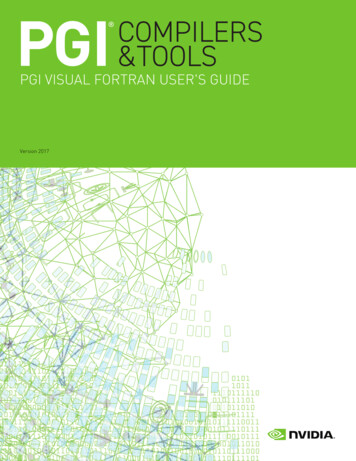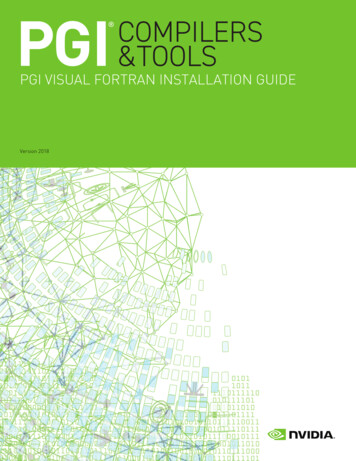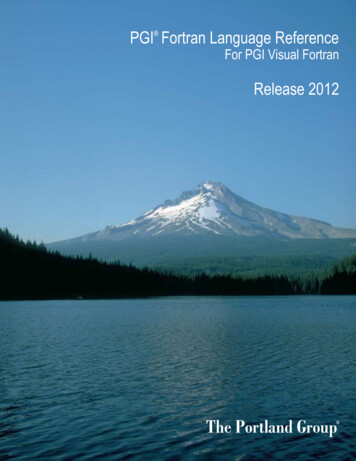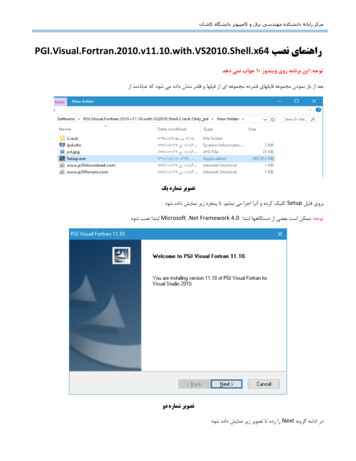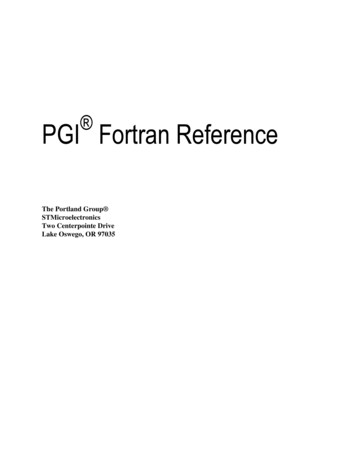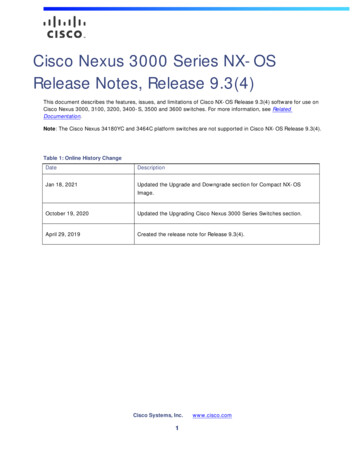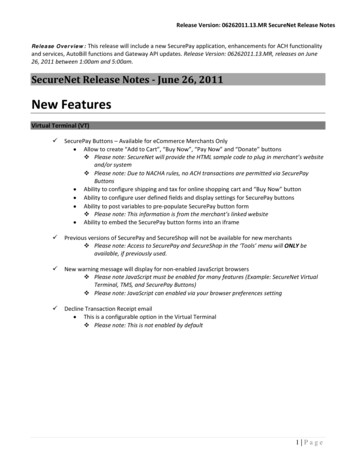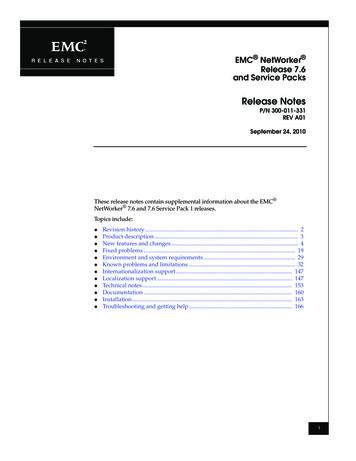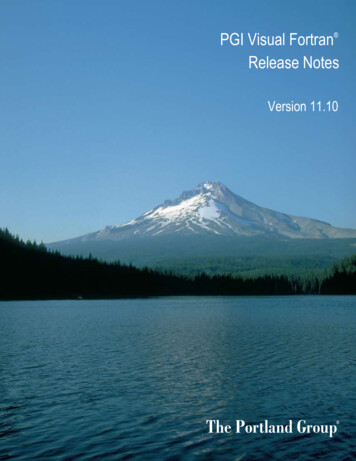
Transcription
PGI Visual Fortran Release NotesVersion 11.10The Portland Group
While every precaution has been taken in the preparation of this document, The Portland Group (PGI ), a wholly-owned subsidiary of STMicroelectronics, Inc., makes nowarranty for the use of its products and assumes no responsibility for any errors that may appear, or for damages resulting from the use of the information contained herein.The Portland Group retains the right to make changes to this information at any time, without notice. The software described in this document is distributed under license fromSTMicroelectronics and/or The Portland Group and may be used or copied only in accordance with the terms of the end-user license agreement ("EULA").PGI Workstation, PGI Server, PGI Accelerator, PGF95, PGF90, PGFORTRAN, and PGI Unified Binary are trademarks; and PGI, PGHPF, PGF77, PGCC, PGC , PGI Visual Fortran,PVF, PGI CDK, Cluster Development Kit, PGPROF, PGDBG, and The Portland Group are registered trademarks of The Portland Group Incorporated. Other brands and names areproperty of their respective owners.No part of this document may be reproduced or transmitted in any form or by any means, for any purpose other than the purchaser's or the end user's personal use without theexpress written permission of STMicroelectronics and/or The Portland Group.PGI Visual Fortran Copyright 2010-2011 The Portland Group and STMicroelectronics, Inc.All rights reserved.Printed in the United States of AmericaFirst Printing: Release 2011, version 11.0, December 2010Second Printing: Release 2011, version 11.1, January 2011Third Printing: Release 2011, version 11.2, February 2011Fourth Printing: Release 2011, version 11.3, March 2011Fifth Printing: Release 2011, version 11.4, April 2011Sixth Printing: Release 2011, version 11.5, May 2011Seventh Printing: Release 2011, version 11.6, June 2011Eighth Printing: Release 2011, version 11.7, July 2011Ninth Printing: Release 2011, version 11.8, August 2011Tenth Printing: Release 2011, version 11.9, September 2011Eleventh Printing: Release 2011, version 11.10, October 2011Technical support: trs@pgroup.comSales: sales@pgroup.comWeb: www.pgroup.comID: 112911425
Contents1. PVF Release Overview . 1Product Overview . 1Terms and Definitions . 22. New or Modified Features . 3What's New in PVF Release 2011 . 3PGI Visual Fortran Additions . 6General Enhancements . 7Fortran 2003 features . 7Fortran Modules . 9PGI Accelerator and CUDA Fortran Enhancements . 9New or Modified Compiler Options . 12New or Modified Runtime Library Routines . 14New or Modified Properties . 14New or Modified Tools Support . 15PGPROF . 15PGDBG . 15MPI Support . 16Fortran 2003 Support Overview . 16I/O Support . 16Data-related Enhancements . 17Object-Oriented Programming Enhancements . 18Interoperability with C Enhancements . 19Miscellaneous F2003 Enhancements . 193. Selecting an Alternate Compiler . 21For a Single Project . 21For All Projects . 214. Distribution and Deployment . 23Application Deployment and Redistributables . 23PGI Redistributables . 23iii
Microsoft Redistributables . 245. Troubleshooting Tips and Known Limitations . 25Use MPI in PVF Limitations .PVF IDE Limitations .PVF Debugging Limitations .PGI Compiler Limitations .Corrections .25252626266. Contact Information . 27iv
Chapter 1. PVF Release OverviewWelcome to Release 2011 of PGI Visual Fortran , a set of Fortran compilers and development tools for 32bit and 64-bit x86-compatible processor-based workstations and servers running versions of the Windowsoperating system.This document describes the new features of the PVF IDE interface, differences in the PVF 2011 compilersand tools from previous releases, and late-breaking information not included in the standard productdocumentation.PGI Visual Fortran (PVF ) is licensed using FLEXnet, the flexible license management system from FlexeraSoftware*. Instructions for obtaining a permanent license are included in your order confirmation. Moreinformation on licensing is in the PVF Installation Guide for this release.Product OverviewThere are two products in the PVF product family. Each product is integrated with a particular version ofMicrosoft Visual Studio: PGI Visual Fortran 2010This product is integrated with Microsoft Visual Studio 2010 (VS 2010). PGI Visual Fortran 2008This product is integrated with Microsoft Visual Studio 2008 (VS 2008).Throughout this document, "PGI Visual Fortran" and “PVF” refer to all PVF products collectively. Similarly,"Microsoft Visual Studio" refers to VS 2010 and VS 2008. When it is necessary to distinguish between theproducts, the document uses the full product name.Single-user node-locked and multi-user network floating license options are available for all PVF products.When a node-locked license is used, one user at a time can use PVF on the single system where it is installed.When a network floating license is used, a system is selected as the server and it controls the licensing,and users from any of the client machines connected to the server can use PVF. Thus multiple users cansimultaneously use PVF, up to the maximum number of users allowed by the license.PVF provides a complete Fortran development environment fully integrated with Microsoft Visual Studio. Itincludes a custom Fortran Build Engine that automatically derives build dependencies, a Fortran-aware editor,1
Terms and Definitionsa custom PGI Debug Engine integrated with the Visual Studio debugger, PGI Fortran compilers, and PVFspecific property pages to control the configuration of all of these.Release 2011 of PGI Visual Fortran includes the following components: PGFORTRANTM native OpenMP and auto-parallelizing Fortran 90/95/2003 compiler. PGF77 native OpenMP and auto-parallelizing FORTRAN 77 compiler. PGPROF Performance Profiler PVF Visual Studio integration components AMD Core Math Library 4.4.0 (ACML) PVF documentationPGI Visual Fortran is available with the Microsoft Visual Studio Shell. Use this package if you do not alreadyhave Visual Studio installed on your system. Otherwise, download the versions of PVF without the VS Shell,since these are much smaller.Terms and DefinitionsThese release notes contain a number of terms and definitions with which you may or may not be familiar. Ifyou encounter a term in these notes with which you are not familiar, please refer to the online glossary atwww.pgroup.com/support/definitions.htmThese two terms are used throughout the documentation to reflect groups of processors: AMD64 – a 64-bit processor from AMD designed to be binary compatible with 32-bit x86 processors,and incorporating new features such as additional registers and 64-bit addressing support for improvedperformance and greatly increased memory range. This term includes the AMD Athlon64, AMD Opteron,AMD Turion, AMD Barcelona, AMD Shanghai, AMD Istanbul, and AMD Bulldozer processors. Intel 64 – a 64-bit IA32 processor with Extended Memory 64-bit Technology extensions designed to bebinary compatible with AMD64 processors. This includes Intel Pentium 4, Intel Xeon, Intel Core 2, IntelCore 2 Duo (Penryn), Intel Core (i3, i5, i7) both first generation (Nehalem) and second generation (SandyBridge) processors.2
Chapter 2. New or Modified FeaturesThis chapter contains the new or modified features of this release of PGI Visual Fortran as compared to priorreleases.What's New in PVF Release 2011Most Recent Updates and Additions Support is available for AMD’s Bulldozer based processor. The option -tp now supports the suboptionbulldozer. Hardware count-based profiling support for both Sandybridge and Bulldozer based processors is available.Use pgcollect -hwtime11.8 Updates and Additions PGI 11.8 includes an update of Cygwin to version 1.7.9-1. PGI Accelerator compilers and CUDA Fortran include these modifications and enhancements: CUDA Fortran supports the option -mcmodel medium. PGI provides a module which defines interfaces to the CUBLAS Library from PGI CUDA Fortran. Theseinterfaces are made accessible by placing the following statement in the CUDA Fortran host-codeprogram unit:use cublas11.7 Updates and Additions Fortran 2003 now supports final subroutines that allow the programmer to specify subroutine(s) that getcalled when a variable is deallocated or ceases to exist (i.e., no longer in scope). zThis allows the program to clean up, perhaps release some resources, when the variable no longer exists.For more information, refer to “Object-Oriented Programming Enhancements,” on page 18. PGDBG has a number of enhancements in this release:3
What's New in PVF Release 2011 New graphical presentation of stack trace information in PGDBG's Call Stack tab. Enhanced support for command-line editing in PGDBG text mode and the PGDBG GUI's CommandPrompt tab. Includes support for arrow and control keys and, in the GUI, text selection and replacement.11.6 Updates and Additions The ALLOCATE statement now correctly accepts the source qualifier for a polymorphic source type withallocatable members. Support is available for Intel’s Sandy Bridge processor. From the Fortran Target Processorsproperty page, use the property Intel Sandy Bridge, which adds the –tp sandybridge-64 or the–tp sandybridge-32 switch to the compilation line. The option -Mvect now supports the suboption simd[{128 256}] which specifies to vectorize usingSIMD instructions and data, either 128 bits or 256 bits wide, on processors where there is a choice.From the Fortran Optimization Vectorization property page select the appropriatevectorization type. For more details, refer to “New or Modified Properties,” on page 14. PGI Accelerator compilers and CUDA Fortran include these modifications and enhancements: The default CUDA Toolkit version is now 3.2; the previous default was 3.1. For how to target a specifictoolkit, refer to “PGI Accelerator and CUDA Fortran Enhancements,” on page 9 Added support for the CUDA 4.0 Toolkit. Some features require this toolkit.When using the CUDA 4.0 Toolkit, pgaccelinfo displays the following line:CUDA Driver Version 4000 A cublas emulation library is now provided fro CUDA C for x86. For details on linking in thislibrary, see the simple CUBLAS SDK example. A cublas module is also provided for PGI CUDA Fortranand PGI Accelerator Fortran use. In CUDA Fortran, the print statement is allowed in attributes(global) and attributes(device) rou
Welcome to Release 2011 of PGI Visual Fortran , a set of Fortran compilers and development tools for 32-bit and 64-bit x86-compatible processor-based workstations and servers running versions of the Windows operating system. This document describes the new features of the PVF IDE interface, differences in the PVF 2011 compilers
